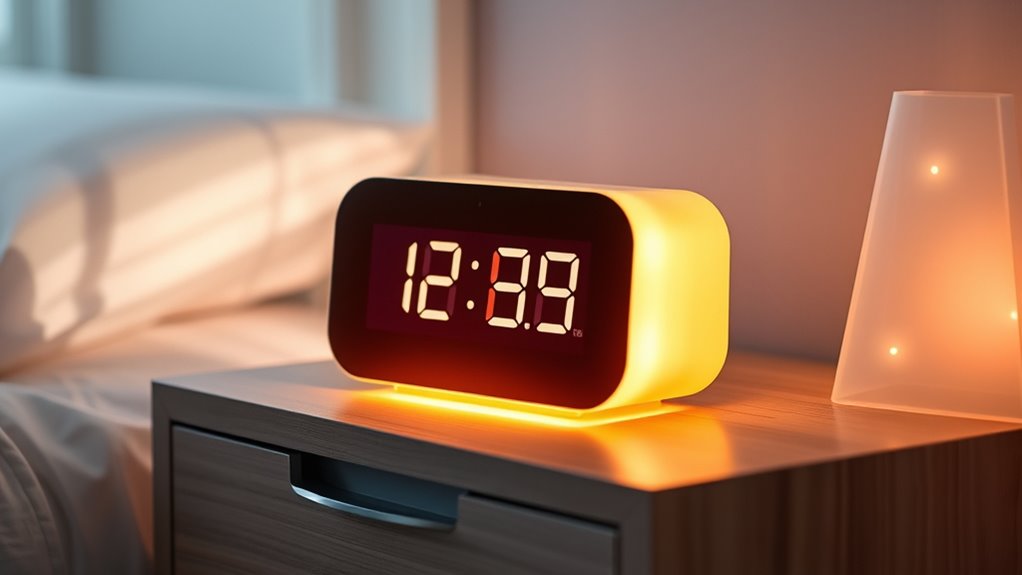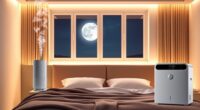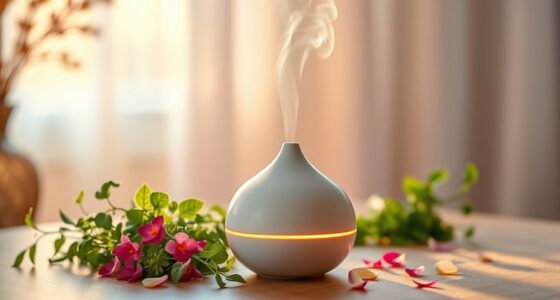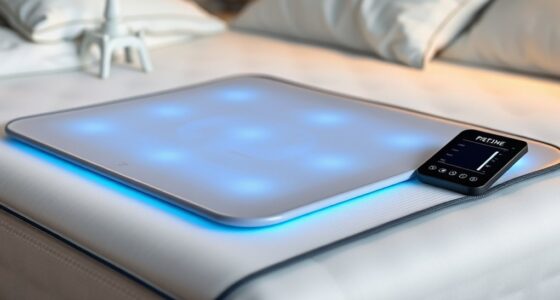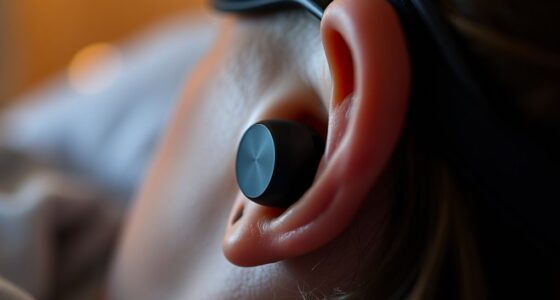Light therapy alarm clocks work by using specific wavelengths, primarily blue and red light, to influence your body’s internal clock and hormone production. Blue light suppresses melatonin, helping you wake up alert, while red light promotes relaxation for better sleep. These devices mimic natural sunlight, signaling your brain to regulate sleep-wake cycles and boost mood through increased serotonin. If you want to understand how these lights can transform your mornings, there’s much more to discover below.
Key Takeaways
- Light therapy alarm clocks use specific wavelengths, mainly blue (~480 nm) and red (~660 nm), to influence alertness and relaxation.
- They mimic natural sunlight by gradually increasing brightness and adjusting color temperature to synchronize circadian rhythms.
- Blue light activates photoreceptors that suppress melatonin, promoting wakefulness and alertness in the morning.
- Proper light exposure from these devices can boost serotonin levels, improving mood and overall well-being.
- Timing and intensity of light exposure are critical for effectively resetting the body’s internal clock and enhancing sleep-wake cycles.
How Light Influences Our Biological Clocks
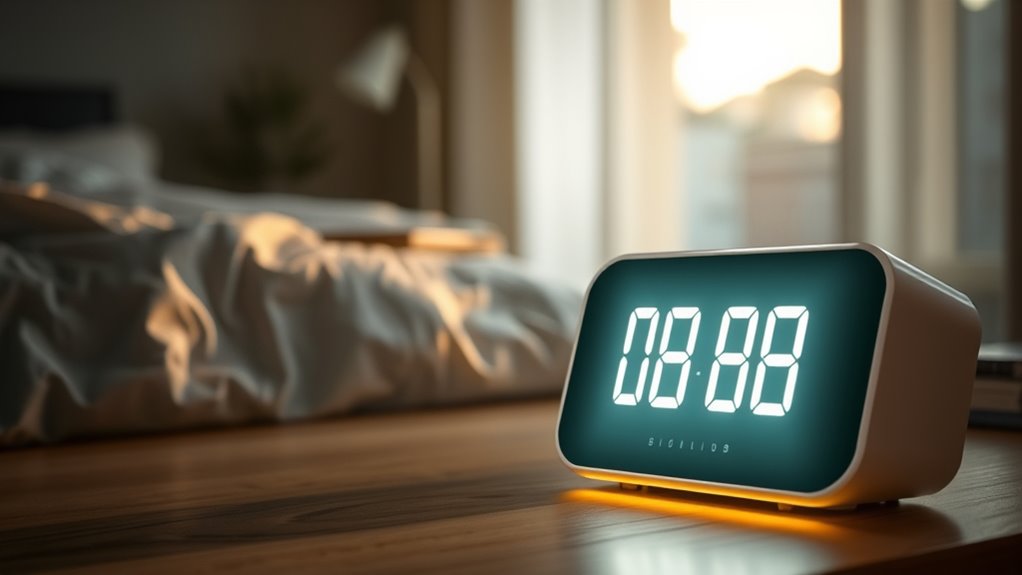
Light plays a crucial role in regulating your body’s internal clock, known as the circadian rhythm. This internal system helps synchronize your sleep-wake cycle with the natural day-night pattern. When light enters your eyes, it interacts with specialized cells called photoreceptors, which are highly sensitive to specific wavelengths. This photoreceptor sensitivity influences how your brain perceives light signals, signaling whether it’s day or night. As a result, exposure to natural or artificial light can either advance or delay your circadian rhythm, affecting sleep and alertness. Understanding this connection highlights the importance of light in maintaining a healthy biological clock. Proper light exposure, especially in the morning, helps keep your circadian rhythm aligned and ideally functioning.
The Role of Wavelengths in Light Therapy Devices
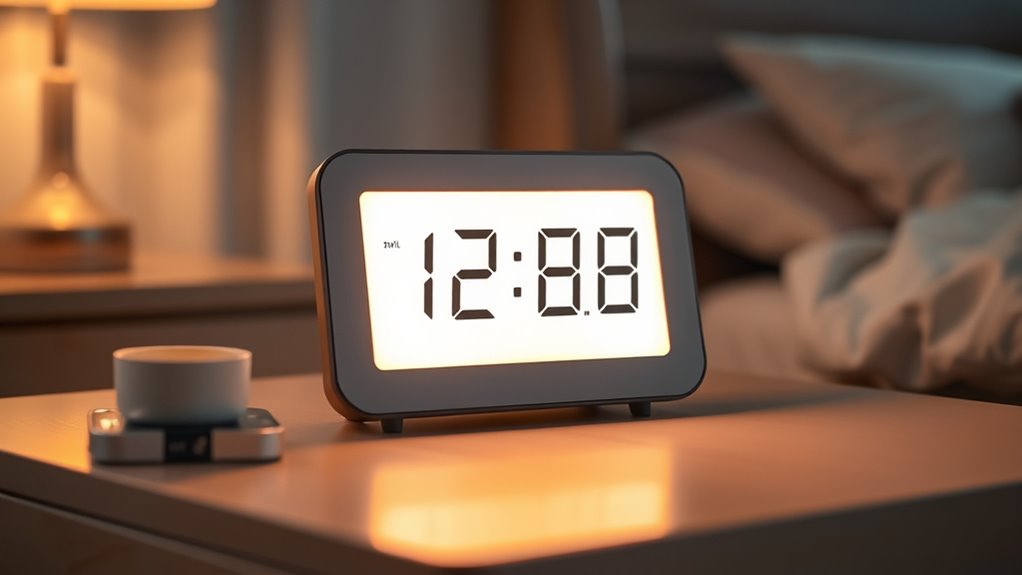
The effectiveness of light therapy devices largely depends on the specific wavelengths they emit. Different wavelengths target various biological responses, making precise light spectrum selection vital. LEDs are commonly used because they can produce specific wavelengths efficiently. For example, blue light (around 480 nm) penetrates deeply, influencing alertness, while red light (around 660 nm) promotes relaxation. Here’s a visual of the light spectrum:
| Wavelength (nm) | Effect | Common Use |
|---|---|---|
| 450-495 | Blue | Wakefulness, alertness |
| 495-570 | Green | Visual comfort |
| 620-750 | Red | Relaxation, healing |
| 780+ | Infrared (not visible) | Deep tissue therapy |
Understanding these wavelengths helps optimize your light therapy alarm clock for better mornings, especially as automation technologies continue to advance in health devices.
Melatonin Suppression and Wakefulness
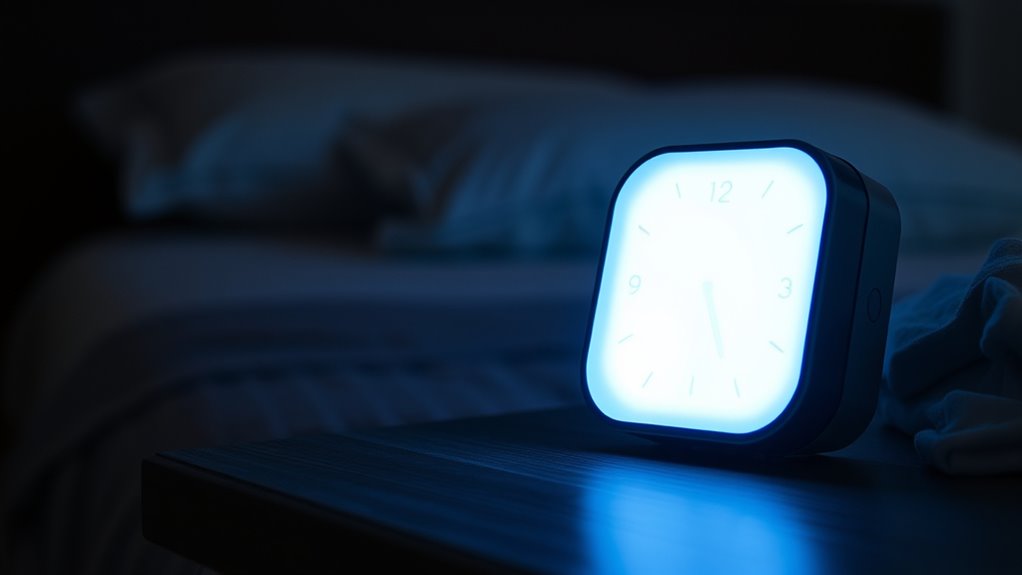
Since melatonin is a hormone that signals your body to prepare for sleep, exposure to certain wavelengths of light before waking can considerably impact your alertness. Light influences your circadian rhythms by activating specific photoreceptors in your eyes, mainly the intrinsically photosensitive retinal ganglion cells (ipRGCs). When these photoreceptors detect blue light, they send signals that suppress melatonin production, making you feel more awake. This suppression helps reset your internal clock, aligning your sleep-wake cycle with external light cues. By strategically using light therapy alarm clocks, you can stimulate photoreceptor activation at the right time, reducing melatonin levels and promoting wakefulness. This process enhances your alertness, ensuring a more energized start to your day. Additionally, understanding how light exposure impacts your biological rhythms can help optimize your morning routines for better health and alertness.
Serotonin Production and Mood Regulation
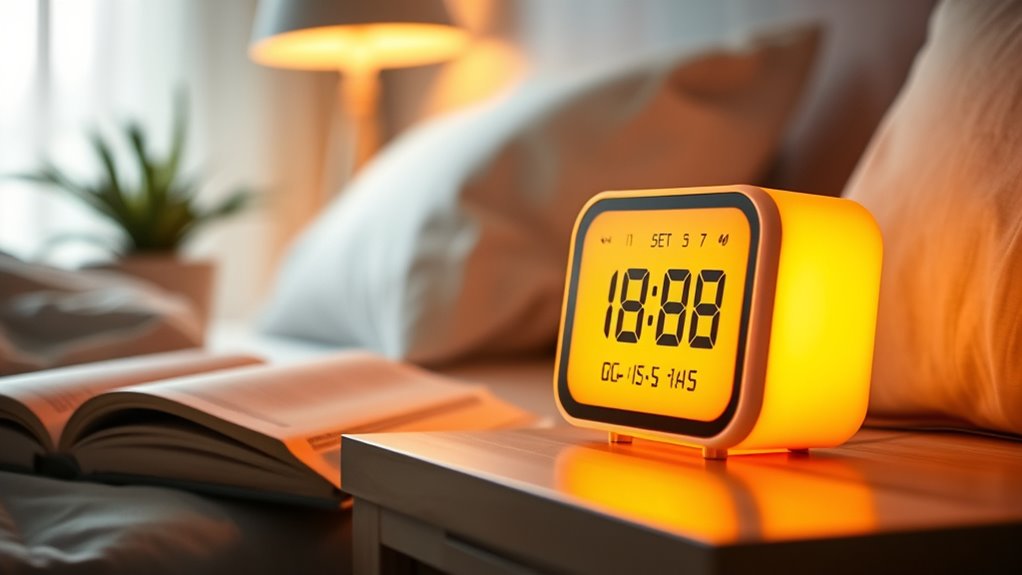
Exposure to specific wavelengths of light not only influences your alertness but also plays a pivotal role in regulating mood through serotonin production. When your light exposure aligns with your circadian rhythms, it can boost serotonin levels, which help improve mood and reduce symptoms of Seasonal Affective Disorder. Proper light exposure encourages your brain to produce more serotonin, essential for feelings of well-being. To maximize these benefits, consider:
- Using light therapy in the morning to simulate natural sunlight
- Ensuring light intensity is sufficient for serotonin stimulation
- Maintaining consistent exposure to support circadian rhythms
- Combining light therapy with outdoor time for added benefits
– Incorporating comfort solutions for sleep can further enhance your overall well-being and support mood regulation.
Mimicking Natural Sunlight for Optimal Sleep-Wake Cycles
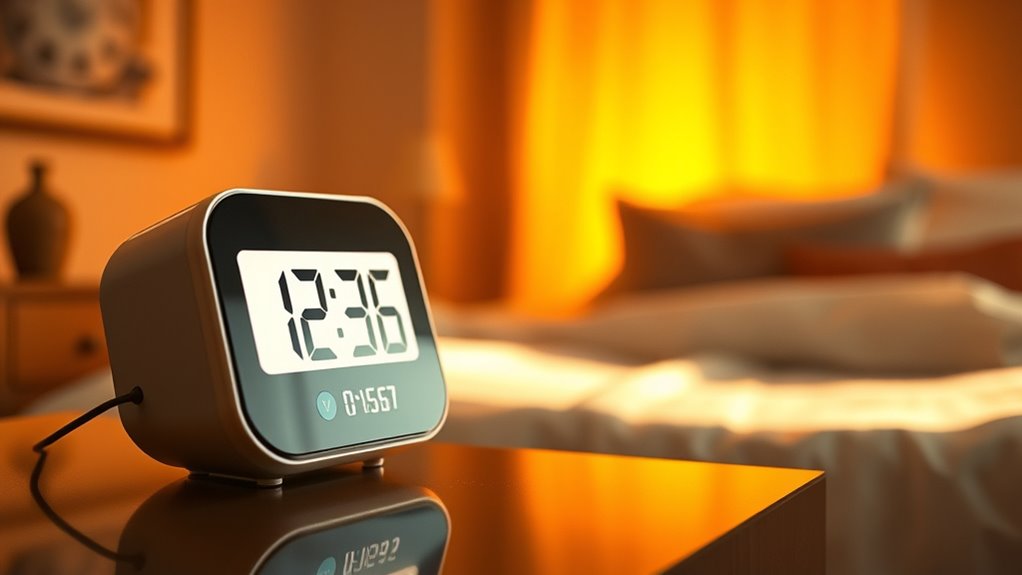
To maintain a healthy sleep-wake cycle, it’s vital to mimic natural sunlight as closely as possible. This means adjusting the light therapy alarm clock to match the natural color temperature of morning sunlight, which is typically around 5000–6500K. Higher color temperatures produce a bluish light that signals your body it’s daytime, helping regulate your internal clock. Equally important is light intensity; you want a gradual increase in brightness that closely resembles sunrise, gradually reaching levels that promote alertness without overwhelming your eyes. By fine-tuning both color temperature and light intensity, your alarm clock can effectively simulate natural sunlight, making waking up easier and supporting your overall circadian rhythm. Proper light simulation enhances the effectiveness of light therapy alarm clocks and can improve your sleep quality. This approach helps you feel more refreshed and aligns your sleep-wake cycles with natural light patterns.
Frequently Asked Questions
How Do Light Therapy Alarm Clocks Compare to Traditional Alarms?
When comparing light therapy alarm clocks to traditional alarms, you’ll find they often improve sleep quality by gently waking you with gradual light rather than sudden sounds. Your user preferences matter; many prefer the natural wake-up experience, which can reduce morning stress. Unlike traditional alarms, light therapy clocks help regulate your circadian rhythm, making mornings easier and more pleasant, especially if you struggle with abrupt awakenings or sleep issues.
Are There Any Side Effects From Using Light Therapy Alarm Clocks?
You might think light therapy alarm clocks are perfect, but they can surprisingly cause some side effects. Ironically, you could experience potential skin irritation from the bright light or even disrupted sleep patterns if you set the alarm too early or too late. While they’re gentle compared to loud alarms, it’s wise to use them carefully, or you might find yourself more awake than you’d like or with a rash to show for it.
Can Light Therapy Help With Seasonal Affective Disorder?
Light therapy can help with seasonal affective disorder by resetting your circadian rhythms, which often get disrupted during winter months. As you use a light therapy alarm clock, it stimulates your brain’s production of serotonin, leading to mood improvement. Regular exposure to bright light in the morning mimics natural sunlight, helping you feel more alert and balanced, ultimately reducing the symptoms of seasonal affective disorder.
What Is the Ideal Duration for Light Therapy Sessions?
Imagine waking up as the morning sun gently floods your room, your eyes soaking in the soft glow. For light therapy, aim for sessions lasting about 20-30 minutes, ideally in the morning. Keep the light intensity around 10,000 lux and maintain consistent session timing daily. This routine helps regulate your circadian rhythm, boosting your mood and energy, especially during darker months.
Do Light Therapy Alarm Clocks Work for All Age Groups?
Light therapy alarm clocks can be effective across various age groups, but their age-related effectiveness varies. For children and teenagers, developmental considerations like sensitivity to light and sleep patterns matter, so consult a healthcare professional. Adults usually respond well, and older adults may benefit from tailored durations. Always consider individual needs, and age-specific guidelines guarantee you use the device safely and effectively for your age group.
Conclusion
Now that you understand how light therapy alarm clocks work, you realize they’re like a magic wand for your day. By syncing with your natural rhythms, they can transform your mornings from sluggish to spectacular—no more sleep zombie mornings! Embrace the power of light and watch as your mood, energy, and sleep improve faster than you can say “good morning.” It’s a game-changer, turning your wake-up routine into a sunrise celebration every single day.
